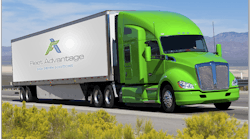When Fleet Advantage released its first quarter 2019 Truck Lifecycle Data Index (TLDI) it was all good news for fleets thinking about trading in older trucks for model year 2020 equipment. The comparison of “all-in” operating cost data for early-model Class-8 trucks to 2020 model-year replacements show significant cost savings.
According to Fleet Advantage’s ATLAAS Unified (Advanced Truck Lifecycle Administrative Analytics Software), the TLDI shows that fleet operators can realize a first-year, per-truck savings of $16,928 when upgrading from a 2015 sleeper model-year truck to a 2020 model. For a fleet of 100 trucks, upgrading to 2020 vehicles can result in savings of as much as $1.7 million.
Fuel savings account for a large portion of the total savings. In fact, fleets can save $6,048 in the first year on fuel expenditures alone when replacing a 2015 model year Class 8 tractor with sleeper with a new 2020 model (based on an average diesel price of $3.08), according to Fleet Advantage. This equals a 12 percent increase in fuel economy and a reduction of CO2 emissions. Maintenance and repair also offer additional significant savings, they note.
These comparisons are important in helping fleet operators determine future procurement plans, including finding what Fleet Advantage calls “the tipping point.” This is the point at which a truck reaches economic obsolescence, and costs more to operate than to replace with newer equipment.
Truck procurement philosophies have been shifting through the years, and many organizations now analyze a fleet’s lifecycle and operating costs as variable versus fixed expenses, which allows for easier budgeting and forecasting, Fleet Advantage explains. A longer-term lifecycle of a vehicle means organizations have higher variable and unpredictable costs, such as maintenance, fuel expenditures and repairs. If you compare a newer truck to an older truck over the same time frame, the newer truck will have substantially lower fuel and maintenance costs-- reductions which more than offset the increase in the initial fixed cost of the newer truck.
“Over the years the data has continually shown that replacing older trucks with newer, more efficient units can lower the overall cost of a fleet,” said Jim Griffin, COO and chief technology officer for Fleet Advantage. “What’s driving better visibility into this data is leading technology platforms such as ATLAAS Unified, which offer sophisticated business intelligence and analytics, helping fleets interpret vast amounts of data to help them make more intelligent, profit-producing decisions.”
Interpreting data, especially vast amounts of data, has become a task too time-consuming and complex for the old “crunch the numbers” human approach to analysis. There are simply too many variables. For example, to calculate total lifecycle cost, the Fleet Advantage system pulls fuel usage, maintenance and mileage data from each truck’s onboard computer. Then it factors in depreciation, financing, maintenance, repairs and used truck values. The resulting data is aggregated by year, make, model, vehicle manufacturer, vehicle type and location.
That is a lot to consider for just one fleet. As of last fall, however, Fleet Advantage’s ATLAAS system had over six billion miles of data as part of the company’s tracking and analysis and was monitoring over 40,000 vehicles, creating an enormous database for comparisons.
Perhaps surprisingly, there is also a very human-side benefit to using data analysis and sharing technology — it can help people in different workgroups with different responsibilities do a better job communicating with one another. And this can contribute to better collaborative decision making for the good of the enterprise. “What we have learned from our customers is that finance and operations are utilizing different data sets and systems to analyze performance and cost, and this creates a communication gap,” Griffin observed last fall when the company unveiled enhancements to the ATLAAS solution. “With the release of ATLAAS Unified, fleet managers and finance directors have the ability to analyze the same data from different perspectives in the same system to make the right decisions on each truck in the fleet.”
This is no small thing. In a recent Fleet Advantage study, 37.5% of fleet executives cited the inability of their finance departments to clearly communicate the company’s financial metrics and goals for the fleet to the operations department as the largest communications struggle. An additional 34.4% said finance doesn't understand the benefit of investing in newer equipment; and 31.3% said finance doesn't understand various operating costs associated with the fleet.
Click the button below to see the “all-in" cost comparisons of model year (MY) 2013 to 2019 Class 8 trucks with sleepers to 2020 MY trucks with the same specs.



